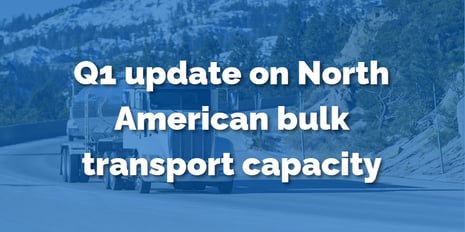Capacity has been a bit easier to come by in the early months of 2023. As such, shippers are getting loads on the move more quickly than just a year ago. When it comes to North American bulk transport, however, there’s a little more to the story than meets the eye. In this article, we’ll look at the current state of bulk freight capacity in North America and tell you what you need to do to secure it.
North American bulk transport capacity has loosened, right?
The simple answer is yes, it has loosened – especially when compared to the last few years.
 That’s because the economy has slowed and there are currently fewer bulk shipments. But, fewer shipments mean fewer trucks on the road. Fewer trucks on the road means fewer opportunities to book return loads.
That’s because the economy has slowed and there are currently fewer bulk shipments. But, fewer shipments mean fewer trucks on the road. Fewer trucks on the road means fewer opportunities to book return loads.
Return loads are beneficial to nearly every bulk supply chain stakeholder. Let’s say a manufacturer is shipping a load from Fresno, CA to Chicago. If the manufacturer has no load going back from Chicago, the truck then has to return to Fresno empty. However, if another shipper is looking for a Chicago-to-Fresno load, then everyone wins: the shipper gets capacity in a timely manner; the carrier is putting its equipment to use; and the truck driver isn’t wasting hours of service by driving ‘empty.’
While the lack of return load opportunities doesn’t mean that there’s a capacity crunch, it does mean that capacity isn’t quite flourishing as it would be with more trucks on the road.
And, of course, we still have a driver shortage that is more acutely felt within the specialized world of bulk transportation.
Still aim to be a ‘shipper of choice’
While the severe carrier’s market of the past few years has reverted back to the middle to some degree, our recommendation as a North American bulk freight broker is to keep a carrier-friendly mindset in 2023. By doing so, you’ll not only secure the capacity you need more easily, you will – just as importantly – forge closer relationships with your carrier and freight broker partners. These relationships can pay serious dividends the next time that capacity tightens.
The following are some of our keys to becoming a shipper of choice for North American bulk transport. For a more comprehensive list, check out our article, 10 Ways to Become a Shipper of Choice for Bulk Freight.
- Be driver friendly. To get carriers to want to work with you, have their drivers want to work with you. Are your facilities driver-friendly? Are instructions for loading and unloading clear and easy to understand? Are your loading and unloading areas safe and easy to reach? Are check-in windows manned? Are weigh scales available on-site or nearby? Is there a secure parking lot where a driver can drop his/her tank or trailer and take a break during loading/unloading? If not, well, these are good starting points to becoming a shipper of choice.
- Give lead time. If you can give your transportation provider advance notice of your loads, then you greatly improve your odds of being accommodated on your chosen lane(s). This is especially true in and around New Jersey, Chicago, Texas and other major hubs. Such forward planning will also plant you firmly in the “easy to work with” category, which will go a long way in making you a shipper of choice.
- Allow bigger windows for shipping and receiving. The more flexibility you can give your transportation partners, the more likely it is that they can fit your loads into their schedules. Carriers are looking to haul more freight in less time, so if you leave them room to fit your products’ loading or unloading in alongside other work, that’s a major advantage.
- Open on nights and weekends, when necessary. We get it, no one wants to open up a facility and bring in staff during hours the facility is normally closed. However, this can sometimes be the determining factor in obtaining the capacity you need. Carriers are operating around the clock. If you can make your facilities available at the times that are most convenient for them, you greatly improve your chances of securing capacity.
- Know and communicate your facility details and potential issues. How many trailers can your facility load or unload in a day? Are there appointments or is it first-come, first-served? If the latter, are trucks backed up as soon as the facility opens? These are the types of things your carrier needs to know so that it can better plan its visit and schedule its day. The more information you communicate at the outset, the more prepared (and appreciative) the carrier will be.
Lean on Bulk Connection in times of tight – or loose – capacity
No matter what the capacity landscape looks like at the moment, Bulk Connection can be a true asset to your North American bulk transport operations. When capacity is tight, you have the ability to lean on our network of bulk freight carriers – one of the largest networks in North America. And, when capacity loosens as it currently has, we can help you find competitive rates for quality service. We always match your distinct product needs with the equipment and capabilities of our fully-vetted carrier network. To learn more about getting your bulk loads on the move, contact Bulk Connection today.




